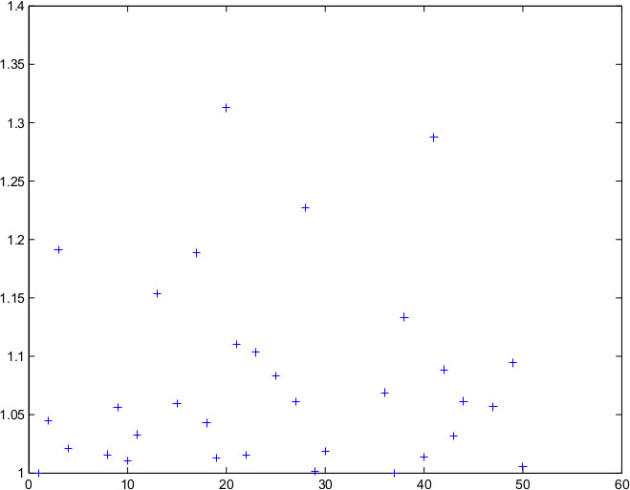Estimates vs exact formula
We assume that the R factor of the QR decomp. of
 is known. Comparison between exact formula and estimates for
is known. Comparison between exact formula and estimates for

| flops | accuracy |
exact formula
|
| exact |
sharp estimate
|
|
|
stat. estimate
|
|
|
Example : Example 1

| bound
| stat. estimate
|
|
|
|
Numerical illustration



| bound
| stat. estimate
|
|
|
|
Truncated SVD solution
We are interested in the truncated SVD solution
 .
.Typically ,

We consider the function

Choice of norms :
 and
and

Differentiability of the singular elements of a matrix (I)

 and
and
 are the
are the
 singular vectors of
singular vectors of

for
 , define
, define
 , and similarly
, and similarly

Set also
 and
and

Assume that the singular values
 are simple and nonzero.
are simple and nonzero.
Differentiability of the singular elements of a matrix (II)
For small enough
 ,
,
with

It is possible (chain rule) to find the Fréchet derivative
 of the truncated SVD solution using these formula
of the truncated SVD solution using these formula
Condition number
Using the
 operation,
operation,
 represents the linear operator
represents the linear operator
 for a particular basis of
for a particular basis of

The condition number
 is
is

Sharp condition number estimate
Let
 ,
,

Define

the quantity
 is such that
is such that

If
 , we get the least-squares condition number
, we get the least-squares condition number
Numerical illustration

Verification
 for matrices of Matlab
for matrices of Matlab

Comparison with a results by P.C. Hansen
Take

An absolute bound [Hansen, 98] gives to first order

Take

 then
then
 for small
for small
 .
.
Conclusion
Adjoint formula for condition numbers in euclidean space may make the CN calculation easier
Relevance of partial condition number shown for test cases from parameter estimation
We can evaluate the sensitivity of
 where
where
 is the solution of a (LLSP) when
is the solution of a (LLSP) when
 and/or
and/or
 are perturbed
are perturbedthe condition number in Frobenius norm can be computed via a close formula, a sharp estimate (factor
 ) or a statistical estimate
) or a statistical estimate
The quantity to compute depends on the size of the problem (computational cost) and on the needed accuracy
The condition number in spectral norm can be estimated using a bound that lies within a factor 2
Pratical applications are planned in the area of geodesy
Sharp condition number obtained for the truncated SVD. Still efforts needed to apply this approach to large problem
























